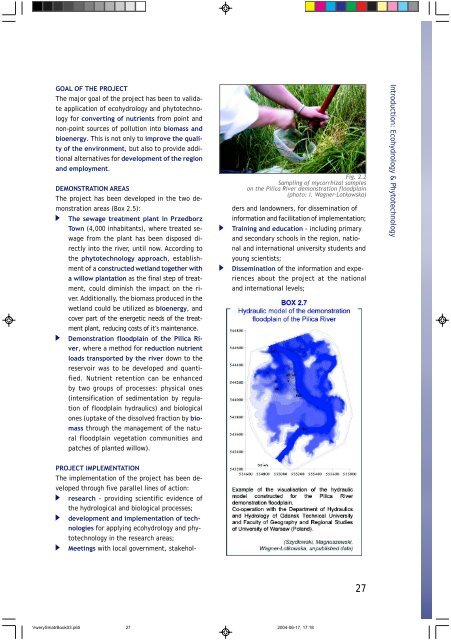Manual - International Environmental Technology Centre
Manual - International Environmental Technology Centre
Manual - International Environmental Technology Centre
You also want an ePaper? Increase the reach of your titles
YUMPU automatically turns print PDFs into web optimized ePapers that Google loves.
GOAL OF THE PROJECT<br />
The major goal of the project has been to validate<br />
application of ecohydrology and phytotechnology<br />
for converting of nutrients from point and<br />
non-point sources of pollution into biomass and<br />
bioenergy. This is not only to improve the quality<br />
of the environment, but also to provide additional<br />
alternatives for development of the region<br />
and employment.<br />
DEMONSTRATION AREAS<br />
The project has been developed in the two demonstration<br />
areas (Box 2.5):<br />
The sewage treatment plant in Przedborz<br />
Town (4,000 inhabitants), where treated sewage<br />
from the plant has been disposed directly<br />
into the river, until now. According to<br />
the phytotechnology approach, establishment<br />
of a constructed wetland together with<br />
a willow plantation as the final step of treatment,<br />
could diminish the impact on the river.<br />
Additionally, the biomass produced in the<br />
wetland could be utilized as bioenergy, and<br />
cover part of the energetic needs of the treatment<br />
plant, reducing costs of it’s maintenance.<br />
Demonstration floodplain of the Pilica River,<br />
where a method for reduction nutrient<br />
loads transported by the river down to the<br />
reservoir was to be developed and quantified.<br />
Nutrient retention can be enhanced<br />
by two groups of processes: physical ones<br />
(intensification of sedimentation by regulation<br />
of floodplain hydraulics) and biological<br />
ones (uptake of the dissolved fraction by biomass<br />
through the management of the natural<br />
floodplain vegetation communities and<br />
patches of planted willow).<br />
PROJECT IMPLEMENTATION<br />
The implementation of the project has been developed<br />
through five parallel lines of action:<br />
research - providing scientific evidence of<br />
the hydrological and biological processes;<br />
development and implementation of technologies<br />
for applying ecohydrology and phytotechnology<br />
in the research areas;<br />
Meetings with local government, stakehol-<br />
Fig. 2.2<br />
Sampling of mycorrhizal samples<br />
on the Pilica River demonstration floodplain<br />
(photo: I. Wagner-Lotkowska)<br />
ders and landowners, for dissemination of<br />
information and facilitation of implementation;<br />
Training and education - including primary<br />
and secondary schools in the region, national<br />
and international university students and<br />
young scientists;<br />
Dissemination of the information and experiences<br />
about the project at the national<br />
and international levels;<br />
VwerySmatrBook03.p65 27<br />
2004-06-17, 17:18<br />
27<br />
Introduction: Ecohydrology & Phytotechnology

















